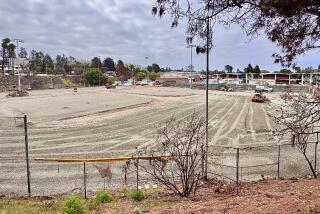Crumbling Carlsbad High’s Plans for Renovation Gathering Dust
- Share via
Teacher Don Getzug doesn’t worry about the patchwork of cellophane and masking tape that supports sagging ceiling tiles in his classroom. He knows that a tile may fall now and then.
But occasionally, Getzug looks at the torn carpet, peeling paint and rusted steel support beams. That’s when he realizes the place is falling apart.
“When you do look around, I think it’s pretty frustrating,” Getzug says. “These are terrible conditions.”
His classroom is not in a ghetto. Getzug teaches English at Carlsbad High School, just a few miles from new homes worth more than $200,000 and with well-heeled La Costa just to the south.
Getzug isn’t the only one to realize that the 32-year-old school needs major repairs. In fact, Getzug’s classroom is one of a dozen the district has scheduled for demolition in a major renovation of the school.
Plans call for replacing about half the school with new facilities, including classrooms, offices, a larger library and a landscaped quad area where students can sit and mingle.
But for now, those plans are gathering dust while the district figures out where it’s going to come up with the funds to do the job. For though the renovation’s first phase is almost complete after many delays, the second, more costly phase of the $9-million to $10-million project has been put on hold for at least a year.
At least part of the blame can be laid at the feet of the city’s recent phenomenal growth, which has pushed Carlsbad’s population above 60,000--that’s 16,000 more residents than just three years ago. The increase forced the Carlsbad Unified School District earlier this month to tap the high school renovation funds for construction of an elementary school on the southern edge of town, where new homes are being built in ever greater numbers.
At the same time, the high school is facing a surge in enrollment at the freshman and sophomore levels, Principal Bill Dunmeyer said.
The money was supposed to be there.
Carlsbad voters passed a proposition last June approving a $5,400 fee to be paid by developers with each new dwelling built. The fees were to be funneled into the district’s coffers for school construction.
However, the proposition was struck down after a state appeal court ruled that all such voter-approved development fees or special taxes are limited to $1.50 per square foot per new residence.
Now, district officials are seeking new options to raise money to finish the high school renovation while attempting to tackle other needs.
“The end thing of all of this is that the project has taken too long,” Dunmeyer said. “I think everybody tends to feel disappointed when they see things happen (such as this delay), but they are realistic when they see how hard it is for school districts to get funding. It’s a horrendous problem in California.”
Carlsbad High, which was built in 1957, was designed to hold about 500 students.
Since then, the 28-acre campus has grown to hold about 1,600 by adding portable classrooms such as Getzug’s, which are now in ramshackle condition. Dunmeyer, principal for the past three years, said a school with Carlsbad High’s student body usually sprawls over 45 to 50 acres.
Talk of Buying Land
There is talk within the district of buying residential land around the school, he said. Right now, however, there is no money to do so.
Some students who will return next year expressed disappointment that the renovation has been delayed.
“Sure it’s crowded,” said Jeff Westbay, a junior. “A lot of students go by and kick in parts of walls” of the portables.
“No one really hangs around too long,” another student said. “They just leave at lunch and when class is over.”
The dozen portable classrooms such as Getzug’s, placed on the campus more than 20 years ago to accommodate the first strains of growth, are surrounded by dirt and trampled grass.
“You can’t keep the grass growing when you have such a high concentration of use,” Dunmeyer said.
Optimism Remains
Parking has also created problems.
At least half the students park on nearby residential streets, Dunmeyer said. Some of them toss trash in the yards and gutters during their lunch break, creating friction with homeowners.
Staff members park in a makeshift lot that once served as multipurpose courts for physical education classes.
But, despite the money crunch and delay, most staffers are optimistic, according to Dunmeyer.
Getzug, who has taught in the district 20 years, said he knows the end will come.
“I don’t think you can do this without chaos,” he said. “At best, the plans are just a framework. You survive.”
More to Read
Sign up for Essential California
The most important California stories and recommendations in your inbox every morning.
You may occasionally receive promotional content from the Los Angeles Times.













